Input interpretation

3-fluorobenzaldehyde
Chemical names and formulas
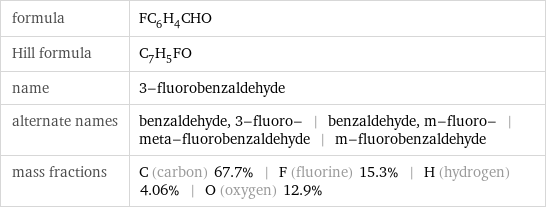
formula | FC_6H_4CHO Hill formula | C_7H_5FO name | 3-fluorobenzaldehyde alternate names | benzaldehyde, 3-fluoro- | benzaldehyde, m-fluoro- | meta-fluorobenzaldehyde | m-fluorobenzaldehyde mass fractions | C (carbon) 67.7% | F (fluorine) 15.3% | H (hydrogen) 4.06% | O (oxygen) 12.9%
Lewis structure
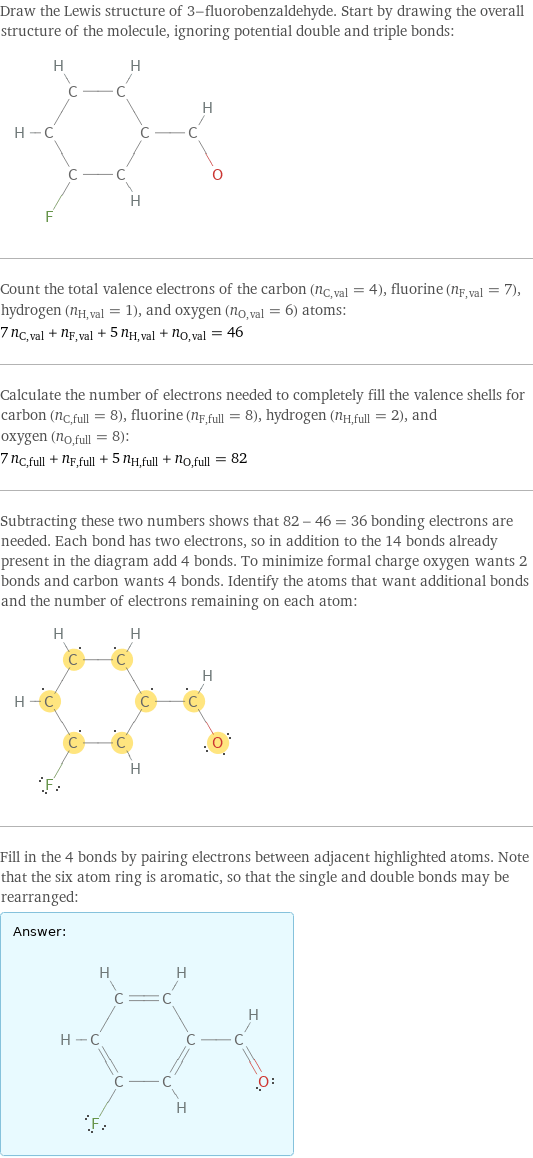
Draw the Lewis structure of 3-fluorobenzaldehyde. Start by drawing the overall structure of the molecule, ignoring potential double and triple bonds: Count the total valence electrons of the carbon (n_C, val = 4), fluorine (n_F, val = 7), hydrogen (n_H, val = 1), and oxygen (n_O, val = 6) atoms: 7 n_C, val + n_F, val + 5 n_H, val + n_O, val = 46 Calculate the number of electrons needed to completely fill the valence shells for carbon (n_C, full = 8), fluorine (n_F, full = 8), hydrogen (n_H, full = 2), and oxygen (n_O, full = 8): 7 n_C, full + n_F, full + 5 n_H, full + n_O, full = 82 Subtracting these two numbers shows that 82 - 46 = 36 bonding electrons are needed. Each bond has two electrons, so in addition to the 14 bonds already present in the diagram add 4 bonds. To minimize formal charge oxygen wants 2 bonds and carbon wants 4 bonds. Identify the atoms that want additional bonds and the number of electrons remaining on each atom: Fill in the 4 bonds by pairing electrons between adjacent highlighted atoms. Note that the six atom ring is aromatic, so that the single and double bonds may be rearranged: Answer: | |
3D structure
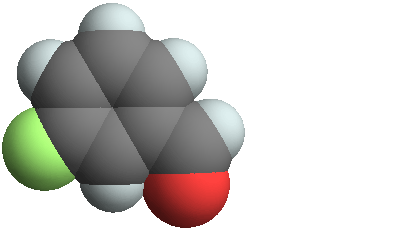
3D structure
Basic properties

molar mass | 124.11 g/mol phase | liquid (at STP) boiling point | 67 °C (measured at 2666 Pa) density | 1.17 g/cm^3 solubility in water | slightly soluble
Units

Liquid properties (at STP)

density | 1.17 g/cm^3 refractive index | 1.518
Units

Chemical identifiers
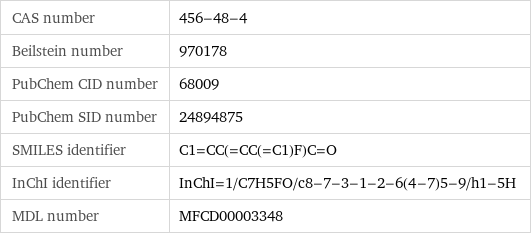
CAS number | 456-48-4 Beilstein number | 970178 PubChem CID number | 68009 PubChem SID number | 24894875 SMILES identifier | C1=CC(=CC(=C1)F)C=O InChI identifier | InChI=1/C7H5FO/c8-7-3-1-2-6(4-7)5-9/h1-5H MDL number | MFCD00003348
NFPA label

NFPA label
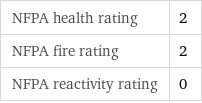
NFPA health rating | 2 NFPA fire rating | 2 NFPA reactivity rating | 0
Safety properties

flash point | 56.67 °C

DOT hazard class | 3 DOT numbers | 1989